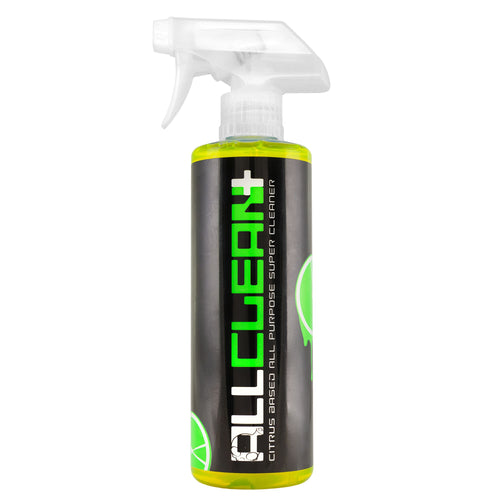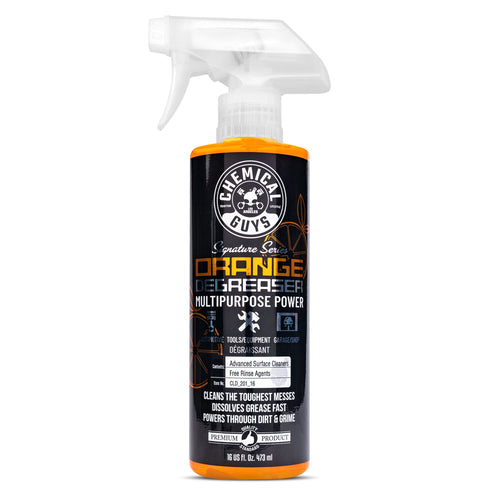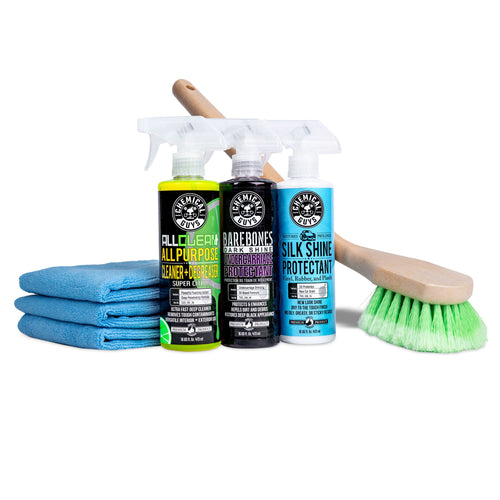Engines collect oil vapor, dust, and road film that bond to surfaces over time. Degreasing removes that layer so you can actually see what’s going on—belts, clamps, hose condition, and any fresh leaks. Clean doesn’t mean “pressure wash the ECU”; it means using the right product, respecting sensitive components, and working with low pressure and good drying. Our how-to playbook keeps it safe: cool engine, cover electronics, use sensible water pressure, and dry thoroughly.
How To Degrease Your Engine Bay Safely (Simple 5-Step Method)
Before you touch a trigger, pop the hood and let things cool – no “pressure washer on stun” heroics here. Bag the intake, alternator, and battery/terminals, then give the bay a gentle pre-rinse to knock off loose dust. Mist on your engine degreaser of choice – Signature Series Orange for heavy grease, All Clean+ or Nonsense for routine grime – let it dwell 15 to 30 seconds, and agitate with a soft brush where needed.
Keep water pressure low and rinse top-down so you’re guiding dirt off the car, not into connectors. Dry thoroughly with microfiber (compressed air is a bonus), remove your covers, and finish plastics and hoses with a light water-based dressing for that even, like-new look. Always test in an inconspicuous spot and mix concentrates to the mildest ratio that gets the job done, your future self will thank you.
- Cool + Cover. Let the engine cool. Bag the intake, alternator, and battery/terminals; remove big plastic covers for better access.
- Pre-Rinse Smart. Use a garden hose or low-pressure setting to knock loose dust—keep at least a foot from sensitive parts.
- Spray The Right Engine Degreaser. Use Orange Degreaser for heavy grease; All Clean+ or Nonsense for routine cleaning. Let it dwell 15 to 30 seconds.
- Agitate Where Needed. Work a soft brush on valve covers, caps, and flat panels; rinse low-pressure.
- Dry + Dress. Towel-dry, blow out crevices, then finish plastics/hoses with a water-based dressing for a uniform, dark sheen. Reconnect what you covered.
Dilution Cheat Sheet (So You Don’t Guess)
Dialing in dilution is the difference between “wow, that cleaned up nice” and “why does this plastic look tired?” Concentrates give you power and control, so you can tune your engine degreaser to the mess in front of you instead of blasting everything with a one-strength-fits-none mix. If you’ve ever wondered what 6:1 actually means, it’s six parts water to one part product (think 24 oz water + 4 oz cleaner in a 28–32 oz bottle).
Pro move: keep two clearly labeled sprayers—one mixed stronger for gnarly jobs, one milder for quick maintenance, so you’re not guessing mid-detail.
Here’s a dilution cheat sheet:
- Signature Series Orange Degreaser: ~6:1 for heavy, 10 to 15:1 for medium, 25 to 40:1 for light. Spray, briefly dwell, scrub if needed, rinse thoroughly.
- All Clean+: Ships full-strength; dilute to suit the job (light to strong) across plastics, wheels, and engine parts. Use our dilution chart if you like numbers.
- Nonsense: Super-concentrated; mix to the mildest ratio that gets the job done for sensitive areas and wipe residue completely.
Always test on a cool, inconspicuous spot first and keep chemistry off hot components. When in doubt, step down in strength and reapply rather than jumping to “full send.”
Wrap-up tips so your ratios actually work for you: mix with cool water, shake to combine, and never let product dry on the surface, short dwell, a little agitation, then rinse and dry. Don’t cocktail cleaners together; pick the right one and stick with it. If you’re working around sensitive plastics or aftermarket bits, start with Nonsense at a light mix and escalate only if needed. Finish by dressing plastics and hoses after they’re dry, your bay will look uniform and stay cleaner longer.




